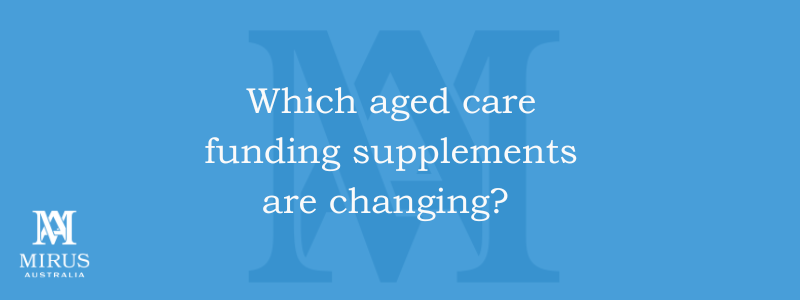The aged care funding supplements that are changing with AN-ACC
June 15, 2022 | Aged Care Finance

By Tyler Fisher, Data Scientist
Some aged care funding supplements paid today as separate supplements are being incorporated to comprise the total AN-ACC funding for the sector. This means that certain aged care funding supplements will be funded through a single AN-ACC subsidy payment rather than a separate supplement.
Which supplements are changing?
AN-ACC funding will incorporate the funding amounts currently provided through the:
- ACFI subsidy
- Homeless supplement
- Viability supplement
- $10 Basic Daily Fee supplement.
How is ACFI funding changing?
Existing ACFI funding will be rolled into AN-ACC from 1 October 2022. This means providers are funded for and are required to provide services to residents in accordance with their obligations under the Aged Care Act 1997 and the associated Quality Standards. A notable change along with the funding is a new and direct link between subsidy and a minimum care minute requirement. While only registered nurse, enrolled nurse, and personal care worker time will be included for the purposes of the care minute requirement, facilities are required to report on all staff time in their ACFR and QFR, including those provided by allied health professionals.
How are Homeless and Viability supplements changing?
Under AN-ACC more equitable care funding is provided to regional, remote, Indigenous and homeless facilities recognising their additional care costs:
- Under ACFI, residents in non-Indigenous facilities in remote (Modified Monash Model (MMM 6) and very remote (MMM 7) locations on average would receive approximately $207 per bed per day compared with approximately $290 per bed per day under AN-ACC.
- Under ACFI, residents located in regional Australia (MMM 5) would receive on average a per bed per day subsidy of approximately $182 compared with approximately $233 per bed per day under AN-ACC.
- Under ACFI, residents located in specialised homeless facilities would receive an average per bed per day subsidy of approximately $227 compared with approximately $303 per bed per day under AN-ACC.
How is the $10 Basic Daily Fee supplement changing?
In the FY22 budget that announced AN-ACC as the new funding model, there was also a $3.2 billion funding uplift in the form of a $10 Basic Daily Fee Supplement which commenced from 1 July 2021. This effectively added an additional $10 of revenue per resident per day. This supplement will be funded through a single AN-ACC subsidy payment rather than a separate supplement after October 1 (or the commencement of AN-ACC).
Will there be any more changes to supplements in the future?
The Australian Government is investing $17.7 billion into an aged care reform package. These measures will produce a once in a generation reform of aged care, providing respect, care and dignity to our senior Australians. The government’s aged care reform plan is focused around five pillars:
- Home care – supporting senior Australians who choose to remain in their own home
- Residential aged care services and sustainability – improving and simplifying residential aged care services and access
- Residential aged care quality and safety – improving residential aged care quality and safety
- Workforce – supporting and growing a better skilled care workforce
- Governance – new legislation and stronger governance
2023 will see the drafting of a completely new Aged Care Act. This Act will seek to address identified gaps in current legislation with the most direct impact to Residential Aged Care funding being through the reform of the Residential Aged Care Accommodation Framework, which will commence from 1 July 2024. The Government will consult with the sector to review the use of Refundable Accommodation Deposits (RADs) to raise capital within the residential aged care sector. This will include investigating new ways to assist residential aged care providers in raising capital.
If you have any questions about the changing aged care funding supplements, please contact us.
Further resources:
Maintain funding momentum by preparing for the AN-ACC transition
The AN-ACC funding model will bring several important changes to your finances, people, processes, data, and systems. Our team has been focused on the aged care sector for over a decade and we bring this experience, coupled with the combined experiences of our clients, to help you plan for these changes.
Find out about our transition support service
Need support with a rostering platform that is ready for AN-ACC?
Our Mirus Works! workforce management software is a comprehensive rostering tool that provides real-time data and award interpretation which helps reduce unplanned overtime costs, saves you time managing rosters and enables a more engaged, more connected workforce.
Click here to visit Mirus Works!
For more information on AN-ACC, visit our AN-ACC Resources Hub.
The AN-ACC Resource Hub contains tools, insights and solutions to help you prepare your organisation to transition to AN-ACC so that you’re ready for October. Find out more by visiting the Hub.
Keep updated by joining our mailing list. You’ll be sent two emails a month packed with industry data, trends and insights. Sign up here.


